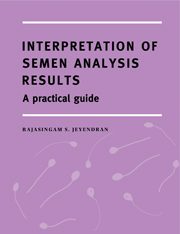Book contents
- Frontmatter
- Contents
- Preface
- Introduction
- Hypotheses on fertile ejaculate identification
- Male reproductive system background
- Semen analysis interpretation
- ROUTINE SEMEN ANALYSIS
- SPECIALIZED SEMEN ANALYSIS
- The logical sequence of routine and specialized semen analysis
- Semen component point-of-origin
- Conclusion
- Standard semen variable reference values for clinical interpretation and diagnosis (Table 1)
- Specialized semen test reference values for clinical interpretation and diagnosis (Table 2)
- Spermatozoa biochemical analysis and seminal plasma chemical analysis reference values for clinical interpretation and diagnosis (Table 3)
- Glossary
- Suggested additional reading
- Index
Semen analysis interpretation
Published online by Cambridge University Press: 05 August 2016
- Frontmatter
- Contents
- Preface
- Introduction
- Hypotheses on fertile ejaculate identification
- Male reproductive system background
- Semen analysis interpretation
- ROUTINE SEMEN ANALYSIS
- SPECIALIZED SEMEN ANALYSIS
- The logical sequence of routine and specialized semen analysis
- Semen component point-of-origin
- Conclusion
- Standard semen variable reference values for clinical interpretation and diagnosis (Table 1)
- Specialized semen test reference values for clinical interpretation and diagnosis (Table 2)
- Spermatozoa biochemical analysis and seminal plasma chemical analysis reference values for clinical interpretation and diagnosis (Table 3)
- Glossary
- Suggested additional reading
- Index
Summary
Semen analysis is usually performed as part of the comprehensive investigation of an infertile couple. Interpretation of these analysis results plays a vital role in the overall treatment of infertile couples. All semen samples, regardless of collection circumstances, have the potential for providing at least some meaningful information, and should therefore be analyzed.
Semen analysis can involve several distinct techniques and procedures. The basic procedure is simply called routine semen analysis,composed of:
Macroscopic analysis
Determination of semen appearance, coagulation and liquefaction time, color and odor, viscosity, and volume.
Microscopic analysis
Determination of the presence of non-sperm cellular elements, sperm agglutination, sperm concentration, sperm motility, and sperm morphology.
Standard parameters are routinely used to indicate the potential fertility ‘status,’ of a specimen, i.e., sperm concentration, motility, and morphology. While important, they have significant limitations, unless these variables are highly abnormal.
A number of highly specialized semen analyseshave therefore been developed to circumvent this deficiency and aid in a more accurate diagnosis of male factor infertility and its etiology, and include:
(i) Sperm function teststhat determine the ability of spermatozoa to migrate into the cervical mucus or other adequate substitute. These tests also evaluate the sperm capacity to respond to hypoosmotic stress or to exclude supravital dyes, to undergo membrane changes (such as sperm capacitation and acrosome reaction). They also determine sperm ability to bind to the human zona pellucida, or the sperm ability to penetrate into zona free hamster oocytes.
(ii) Sperm nuclear integrity testsdetermine the normal chromatin condensation of the nucleus, and ascertain the stability of sperm DNA.
(iii) Antisperm antibody testsfor the blood serum, seminal plasma, spermatozoa, and cervical mucus.
(iv) Biochemical analysis of spermatozoato determine the activity of fertilization enzymes such as sperm acrosin and metabolic enzymes such as sperm creatine phosphokinase. The analysis also may determine the adenosine triphosphate content as well as reactive oxygen species.
(v) Chemical analysis of seminal plasmadetermines the concentration of zinc, citric acid, acid phosphatase, fructose (reducing sugar) and a-glucosidase content, including seminal plasma pH. Note that one specific chemical marker for each accessory sex gland is sufficient to determine the respective gland's contribution.
Such an assessment reveals spermatozoon testicular output, functional properties of spermatozoa, and accessory sexual glands secretory function.
- Type
- Chapter
- Information
- Interpretation of Semen Analysis ResultsA Practical Guide, pp. 21 - 22Publisher: Cambridge University PressPrint publication year: 2000



